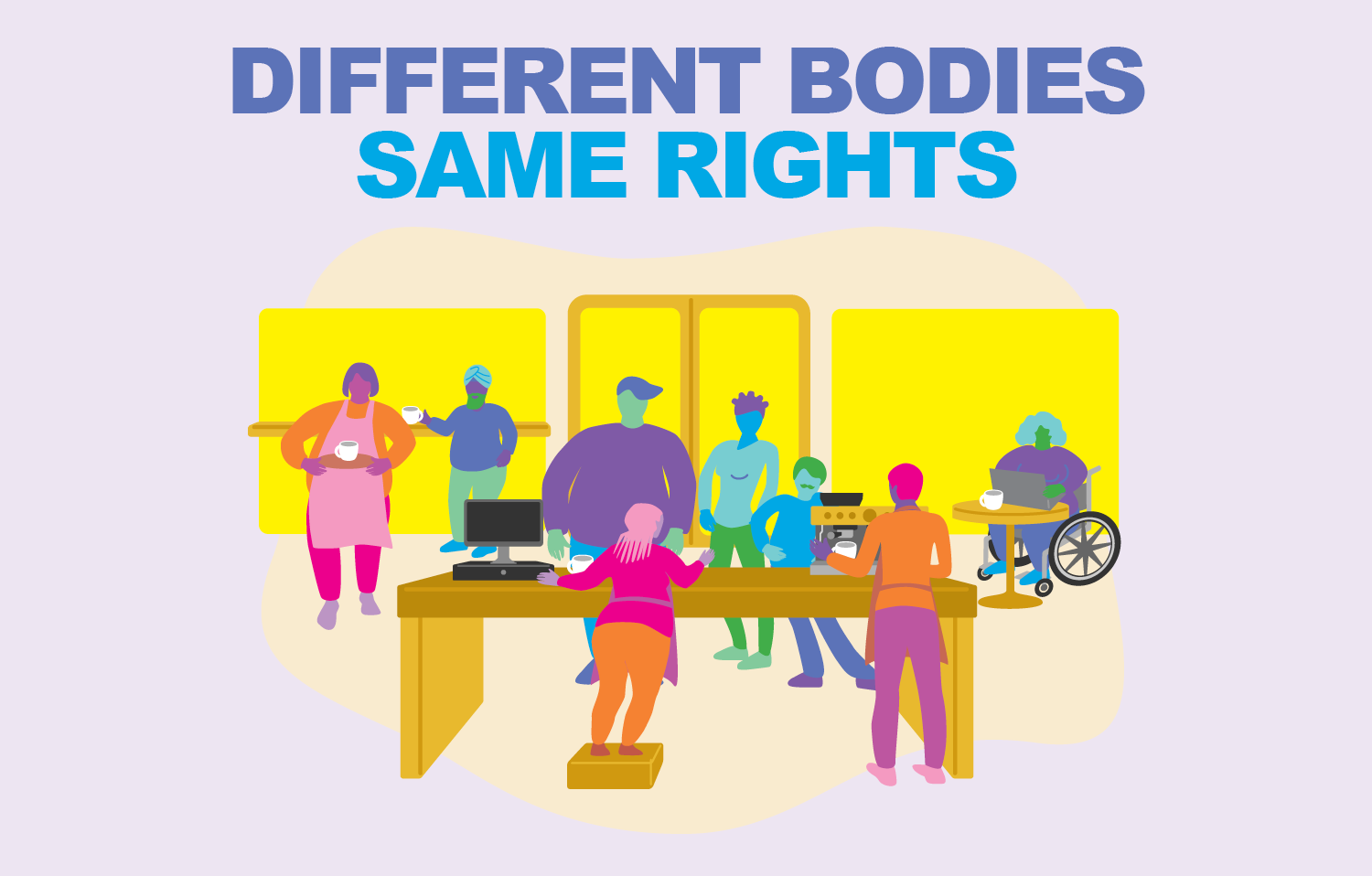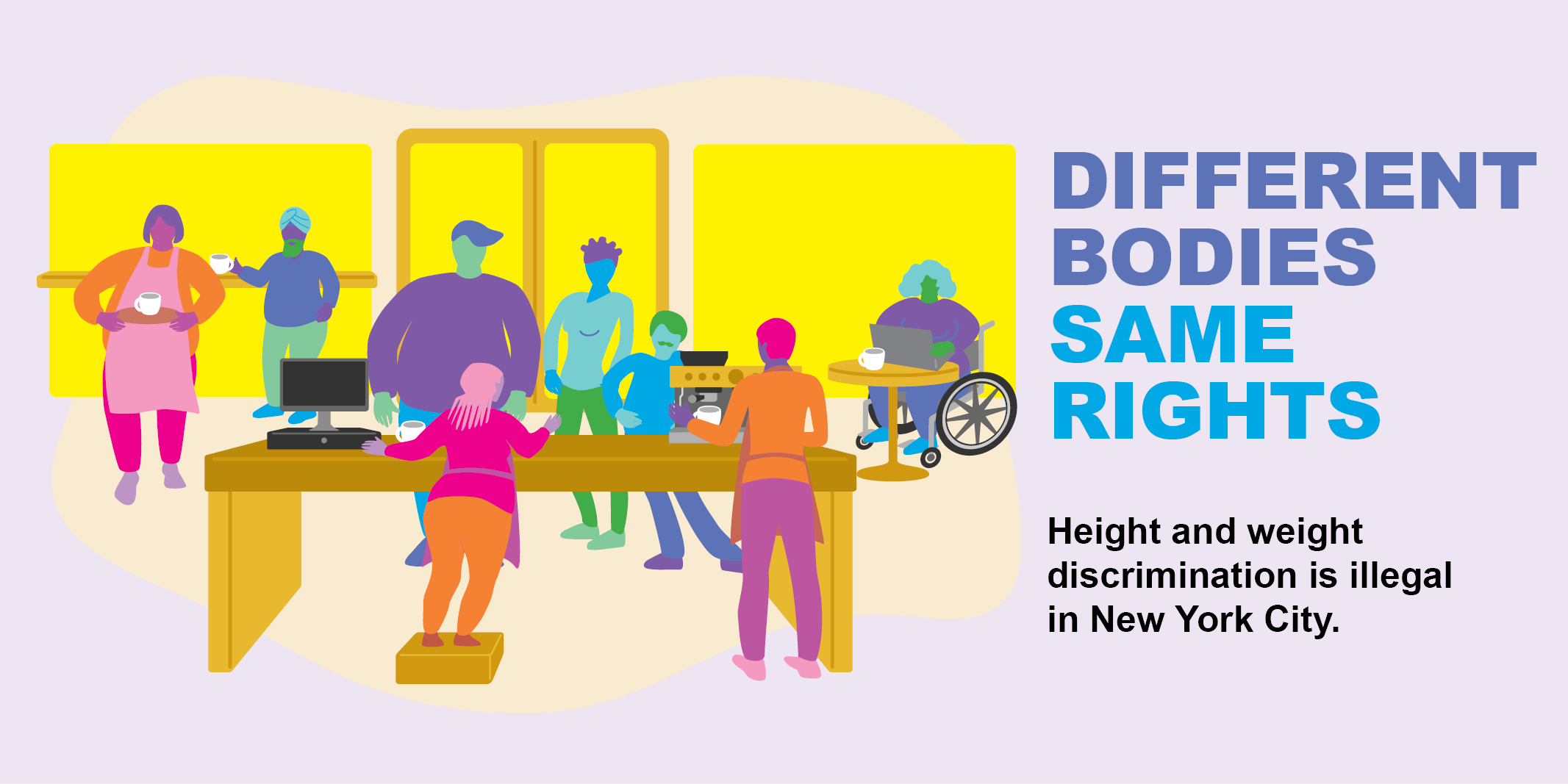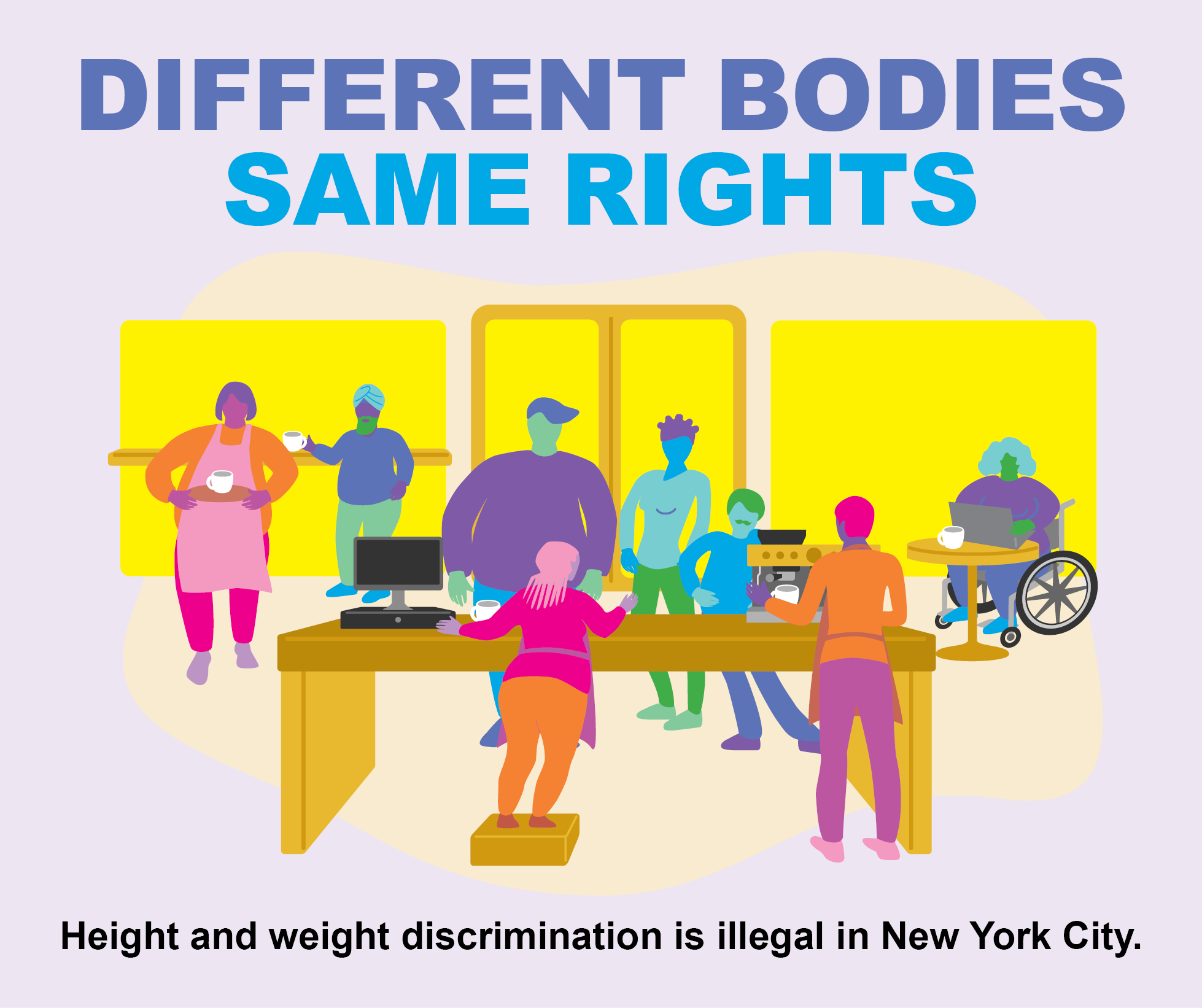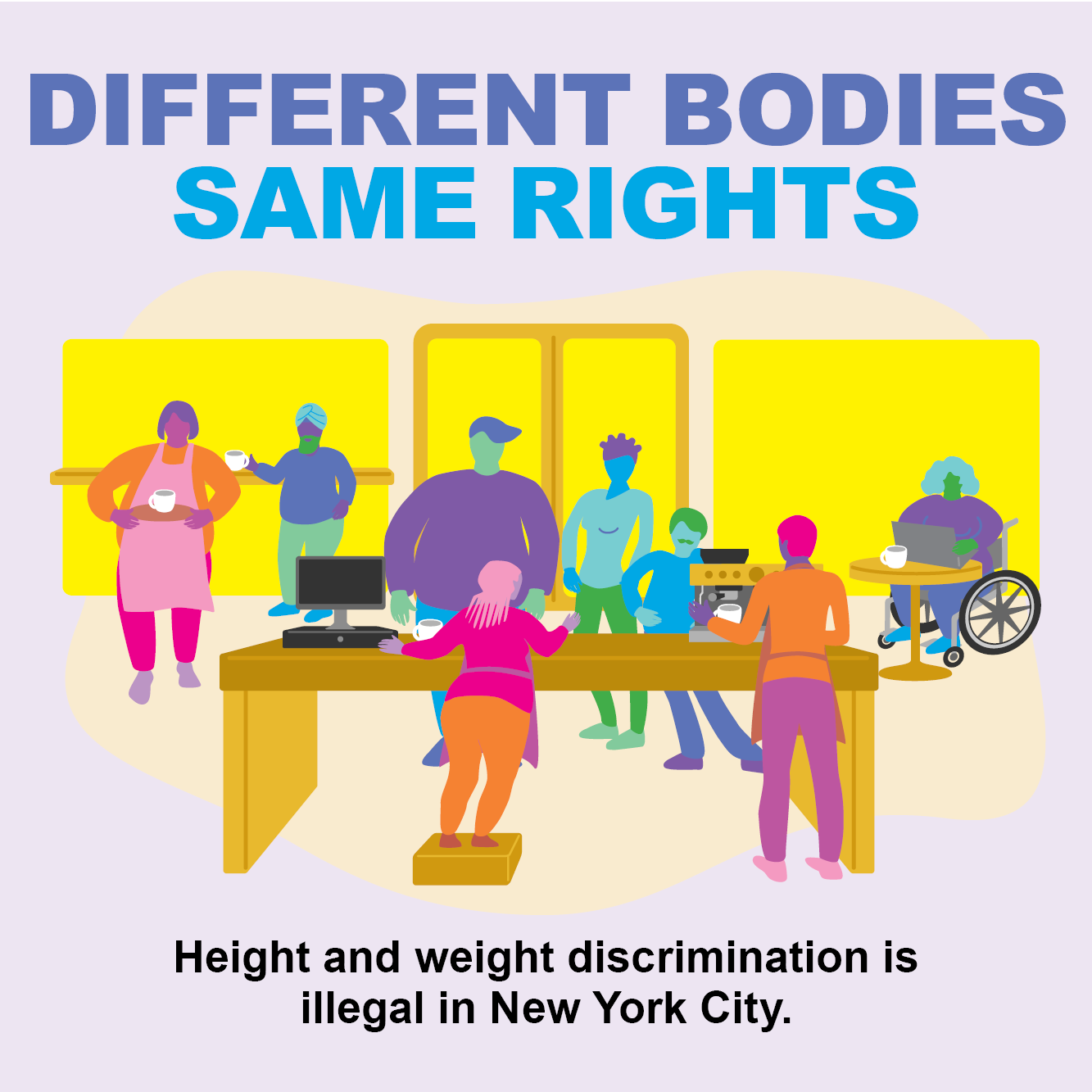
 Human Rights311
Human Rights311 Search all NYC.gov websites
Search all NYC.gov websites
Height and Weight Protections in the New York City Human Rights Law

Height and weight discrimination is illegal in New York City.
Overview
- Entities that are covered by the NYCHRL include employers with four or more employees or one or more domestic worker, housing providers, and public accommodations (“covered entities”).
- Covered entities may have obligations in different parts of the Law. For example, a department store is a public accommodation as it relates to patrons, and an employer as it relates to job applicants and employees.
It is a violation of the height and weight protections for a covered entity to engage in the following conduct if it is based on an individual’s height, weight, or body size:
- Refusing to hire or promote someone; refusing to provide housing, or refusing services;
- Offering different lease terms, conditions of employment, or access to facilities;
- Expressing, directly or indirectly, that an individual will, or may, be treated differently;
- Using harassing or offensive language;
- Creating or permitting a hostile environment;
- For an employer or public accommodation: failing to allow or consider alternative actions when required by the NYCHRL.
There are limited circumstances in which employers and public accommodations may take height, weight, or body size criteria into account, described in the workplace and public accommodations sections below. Additionally, employers and public accommodations are required in some circumstances to take practicable measures to comply with the Law.
There are no exceptions to the height and weight provisions of the law for housing providers.
All exceptions to the NYCHRL are construed narrowly to deter discriminatory conduct, and to promote equitable treatment.
Stereotypes or speculative health and safety concerns regarding body size stem from entrenched bias and do not constitute permissible justifications for height or weight discrimination.
The NYCHRL’s height and weight provisions are in addition to the rights and responsibilities in the NYCHRL related to other protected classes, which include but are not limited to age, color, disability, gender, gender identity, national origin, and race. The NYCHRL is interpreted consistent with federal laws.
Anyone can be a victim of discrimination or bias because of their height, weight, or body size.
If you experience or witness discrimination, contact the Commission at 212-416-0197 or report discrimination online. You can file a complaint or leave an anonymous tip. You may also sign up for a free workshop on your rights as a tenant or employee, or obligations as an employer or housing provider.
Frequently Asked Questions
The following FAQs are intended to inform employers, housing providers, and public accommodations about Local Law 61 of 2023, prohibiting height and weight discrimination and to educate New Yorkers on their rights.
Click a topic, or press the enter key on a topic, to reveal its answer.
General Responsibilities
Which employers have to comply with the NYCHRL prohibitions on discrimination based on height or weight?
Employers with four or more employees and employers with one or more domestic worker have to comply with the Human Rights Law. As with other provisions of the NYCHRL, owners and individual employers count towards the four employees. The four employees do not need to work in the same location, and they do not need to all work in New York City.
Who has workplace protections against height or weight discrimination under the NYCHRL?
The NYCHRL’s workplace protections extend to many groups of workers, including interns and independent contractors. Height and weight protections apply to applicants and individuals that are employed. There are limited circumstances where height, weight, or body size criteria may be taken into account in employment, described in the workplace section below.
Which public accommodations have to comply with the NYCHRL prohibition on discrimination based on height or weight?
Places or providers of goods, services, facilities, or accommodations have to comply with the Human Rights Law. Examples of public accommodations include owners and operators of restaurants, parks, cinemas, theaters, libraries, hospitals, supermarkets, department stores, and their employees and agents. In these spaces, it is unlawful to discriminate based on height or weight. There are limited circumstances where height, weight, or body size criteria may be taken into account in public accommodations, described in the public accommodations section below.
Which housing providers have to comply with the NYCHRL prohibition on discrimination based on height or weight?
Persons or entities that sell, rent or lease, or approve the sale, rental or lease of a housing accommodation, and their agents and employees have to comply with the Human Rights Law. Landlords, managing agents, brokers and real estate agents are prohibited from discriminating based on height or weight.
Are there any exceptions to the NYCHRL’s height and weight protections?
Under the NYCHRL, height, weight or body size are never permissible criteria in housing decisions. There are some limited exceptions where height, or weight, or body size may be relevant in both employment and in public accommodations, described in the workplace and public accommodations section below.
The Workplace
What do the NYCHRL’s height and weight provisions require of employers?
Employers, employment agencies, labor organizations, and their agents must treat individuals that seek employment or are employed similarly, regardless of height or weight.
Are parameters or criteria related to height, weight, or body size permissible in employment?
The limited circumstances where parameters or criteria related to body size are permissible in employment are:
- Where it is required by federal, state, or local law or regulation. Like all provisions of the NYCHRL, height and weight will be enforced consistent with the First Amendment.
- For certain jobs, where:
- A person’s height or weight prevents them from performing core job functions and no alternative action would allow the individual to perform the job; or
- Height or weight criteria are reasonably necessary for the execution of the normal operations of the employer.
What does an alternative action look like in the workplace?
An alternative action is a practicable measure that allows an individual to perform core job functions. An alternative action is practicable if it does not require a structural modification, material change to operations, or impose a significant cost on the covered entity.
Practicability for an employer will be based on the circumstances as a whole, which may include the employer’s size, operations, and the timing of the request. In most instances the following measures will be practicable:
- Offering alternative seating so that employees of various body types can utilize the chair that allows them to fulfill core job functions.
- Stocking uniforms for all heights and weights or adjusting uniform requirements if a uniform is not suitable for all body sizes.
- Providing a ladder or stool to allow an individual access to high shelving units.
What if I feel that all my front-office staff must have a similar appearance and want to ensure that they all have a uniform body type because my clients prefer that?
Employers can develop policies to maintain work appropriate appearance, but cannot have policies that target specific heights, weights, or body sizes. Employers are also prohibited from enforcing appearance policies in a discriminatory manner. Clientele preference is not a justification for discrimination.
Our employees have to lift and move boxes everyday, so we only interview applicants that look strong. Is that ok?
No. Employers can have hiring criteria that are essential to a job (e.g. the ability to lift 30 lbs.), and must assess candidates based on their actual ability to meet that criteria – not on speculation or assumptions. Employers cannot treat otherwise qualified candidates differently based on their height, weight, or body size. Employers are also prohibited from enforcing appearance policies in a discriminatory manner. Clientele preference is not a justification for discrimination.
If our policy is neutral and treats every individual the same, how can we be discriminating against anyone?
Policies that seem neutral can still be discriminatory. For instance, an employer may have a uniform policy that requires all employees to purchase or use uniforms provided by the company. While this may seem like a neutral policy, if the employer only stocks uniforms in certain sizes it may result in some employees being unable to obtain uniforms that fit their bodies comfortably. Employers should ensure they have, or can obtain, uniforms in sizes that fit all employees.
Public Accommodations
What do the NYCHRL’s height and weight provisions require of public accommodations?
Public accommodations must enable all patrons the ability to use or enjoy their services or facilities regardless of height, weight, or body size.
What does an alternative action look like in a public accommodation?
An alternative action is a practicable measure which allows an individual to use or enjoy the services, space, or goods offered, but does not require structural modification, material change to operations, or impose a significant cost on the covered entity.
Practicability for a public accommodation will be based on the circumstances as a whole, which may include the entity’s size, operations, and the timing of the request. For example, most full-service restaurants can provide alternative seating to serve patrons of various sizes. Altering the layout of a cafe with limited space, however, may not be practicable.
Are parameters or criteria related to height, weight, or body size permissible in public accommodations?
The limited circumstances where parameters or criteria related to body size are permissible in public accommodations are:
- Where is required by federal, state, or local law or regulation, including health and safety codes; or
- For certain public accommodations, where height or weight criteria are reasonably necessary for normal operations and no alternative action would allow the individual to use or enjoy the services, space, or goods offered.
What if my business reputation is built upon the image we have established, and we give preference to certain body types? Does this qualify as a legitimate business reason to have height or weight criteria in order for patrons to use our services?
No. It violates the law for a public accommodation to refuse to serve or turn people away based on height, weight, or body size. The perception that there is a “business objective” is not a defense to discrimination based on height, weight, or body size. It also is not a defense that a restriction or prohibition is based on customer preference or based on a perception that a person’s body type is “unprofessional,” or inconsistent with a covered entity’s image.
Housing
What do the NYCHRL’s height and weight provisions require of housing providers?
Landlords, property managers, realtors, and their agents must treat applicants seeking housing, and current tenants the same regardless of height, weight, or body size.
Are there any exceptions to the prohibition on height and weight discrimination in housing?
No. Height, weight, or body size are never permissible criteria in housing. Stereotypes or speculative health and safety concerns regarding body size stem from entrenched bias and do not constitute permissible justifications for height or weight discrimination in housing.
I am a realtor, and I choose which units to show applicants based on my decision about which units and buildings would be appropriate or safe for someone of their body size. If I don’t think so, I don’t show it. Is this ok?
No. This is a violation of the Human Rights Law. Stereotypes or speculative health and safety concerns regarding body size stem from entrenched bias and do not constitute permissible justifications for height or weight discrimination. Making assumptions about someone’s ability to utilize a housing space based on body size is unlawful. For example, declining to show a person of a small stature an apartment because it has high ceilings and cabinets violates the NYCHRL. It would also be a violation to refrain from showing a person a unit based on their body size because of speculative concerns about impact on the property.
Similar Provisions of the NYCHRL
Is an alternative action the same as a reasonable accommodation?
No. A reasonable accommodation is a change made to the environment, terms, or privileges in housing, public accommodations, or in a workplace. Individuals are entitled to reasonable accommodations based on disability, pregnancy, religion, and status as a survivor of domestic violence.
When an individual is entitled to a reasonable accommodation, the covered entity is required to engage in a cooperative dialogue to assess the individual’s needs and limitations, review options and provide an accommodation unless doing so would create an undue hardship for the covered entity. (More on reasonable accommodations can be found in our Equal Access brochure.)
In contrast, an alternative action is an adjustment that an employer or public accommodation can practicably make. An alternative action is practicable if it is achievable without requiring a structural modification, material change to operations, or imposing a significant cost on the covered entity.
In employment, an alternative action could be adjustments which allow an individual to perform a job.
In a place of public accommodation, an alternative action could adjustments which allow an individual to use or enjoy the services, space, or goods offered.
- An alternative action does not require a covered entity to engage in a cooperative dialogue or issue a formal determination. A covered entity must assess what measures can be taken looking at the circumstances as a whole, which may include a covered entity’s size, functions, and the timing of the request.
In some situations, the result of an alternative action may look similar to the result of a reasonable accommodation. In some situations, the result of a reasonable accommodation may be much different to the result of an alternative action.
What are my rights if I am a person with a disability and have also experienced body size discrimination?
Whether height, weight, or body size is a disability under the NYCHRL depends on the circumstances. A disability is defined by the NYCHRL as any physical, medical, mental, or psychological impairment of the body. Height, weight, or the combination of these factors are not in and of themselves disabilities under the NYCHRL. However, where an individual’s height, weight, or body size are related to a disability, that person has rights under the Human Rights Law’s disability protections.
Enforcement
What happens if the law is violated?
The Commission can order a respondent to cease and desist from engaging in the unlawful conduct; mandate policy change; and order a respondent to pay for emotional distress damages, among other remedies. The Commissioner may also assess civil penalties (paid to the City of New York) of up to $125,000 for violations, and up to $250,000 for violations that are the result of willful, wanton or malicious conduct, as well as require respondents to take other actions such as training for managers and employees.
Social Media
The New York City Commission on Human Rights launched a public awareness campaign to educate New Yorkers about their new rights and responsibilities. The campaign includes digital advertising and neighborhood marketing efforts. Feel free to share these graphics on your social platforms and link to this page (NYC.gov/DifferentBodiesNYC).





